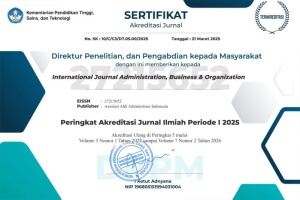Factors That Influence Consumer Purchase Intention In GoFood E-commerce In The Covid-19 Era (Study On People In The City of Bandung, Indonesia)
Abstract
Due to the Covid-19 that has hit Indonesia since 2020, people's activities have become slightly hampered, especially to get goods from outside, one of which is food. Due to its practicality, many people use food ordering applications in this Covid-19 era, one of which is the GoFood application. In addition, there are still many factors that make someone use the GoFood application. Therefore, the purpose of this study is to find out what factors influence consumer purchase intention in GoFood in the Covid-19 era. This study uses a quantitative descriptive method with data analysis using the SPSS v.26 application. This study used a questionnaire measuring instrument and there were 148 GoFood users involved. The data analysis method used is factor analysis, validity test, reliability test, multiple linear regression analysis and correlation. The results of this study there are 4 factors that influence consumer purchase intention on GoFood, namely the perceived usefulness factor, the perceived ease of use factor, the security factor, and the information delivery factor.
References
Agustina, H. (2017). Penggunaan Teknologi Informasi, Kemudahan, dan Fitur Layanan Terhadap Minat Nasabah Dalam Menggunakan Internet Banking (Studi Pada Bank Syariah Mandiri). Jurnal Manajemen Kinerja, 3(1), 24–29.
Chiu, C. M., Wang, E. T. G., Fang, Y. H., & Huang, H. Y. (2014). Understanding customers’ repeat purchase intentions in B2C e-commerce: The roles of utilitarian value, hedonic value and perceived risk. Information Systems Journal, 24(1), 85–114. https://doi.org/10.1111/j.1365-2575.2012.00407.x
Chaniago, Harmon., Mulyawan, Iwan., Suhaeni, Tintin & Jumiyani, Rahil. (2019). Faktor Kunci Keberhasilan Ritel Modern di Indonesia. Jurnal Akuntansi, Ekonomi dan Manajemen Bisnis. Vol 7(2).
Chaniago, Harmon (2021). Understanding purchase motives to increase revenue growth: A study of nanostores in Indonesia. Innovative Marketing , 17(4), 1-12. doi:10.21511/im.17(4).2021.01
Chaniago, Harmon. (2022a). Purchase Motives of Retail Consumers Nanostores: Evidence from Indonesia. Quality Access to Success. Vol 23(186).
Chaniago, Harmon., Sayuti, Abdul Malik. (2022b). The Impact of Social Media Use on Student Entrepreneurship Intention and Implementation: Evidence from Indonesia. Journal of Asian Finance, Economics and Business .Vol 9(2). doi:10.13106/jafeb.2022.vol9.no2.0371
Chung, K., & Shin, J. (2009). The Relationship between Site Characteristics, Relationship Quality, and Word of Mouth. International Journal of Business and Information, 4(2), 137–160. https://doi.org/10.6702/ijbi.2009.4.2.2
Gursida, H. & Harmon. (2017). Metode Penelitian Bisnis dan Keuangan Konsep dan Implementasinya. PASPI.
Kamaluddin & Muhajirin. (2018). Pengaruh Gaya Hidup Terhadap Minat Beli Konsumen Dalam Berbelanja Online (Studi Kasus Pada Mahasiswa STIE BIMA). 3.
Kurnianingsih, H., & Maharani, T. (2020). Pengaruh Persepsi Manfaat, Persepsi Kemudahan, Fitur Layanan Dan Kepercayaan Terhadap Tingkat Kepuasan Pelanggan Linkaja Di Indonesia. Jurnal Ecodemica: Jurnal Ekonomi, Manajemen, Dan Bisnis, 4(2), 200–209. https://doi.org/10.31294/jeco.v4i2.7934
Nurvitasari & Dwijayanti, 2021. (2021). Terhadap Minat Menggunakan Aplikasi Grab ( Studi Pada Pengguna Aplikasi Grab Fitur Grabfood ). 9(3).
Rhamdhani, I. M. (2021). Analisis Niat Beli Konsumen Melalui Online Food Delivery Di Era Pandemic Covid-19. Kajian Bisnis Sekolah Tinggi Ilmu Ekonomi Widya Wiwaha, 29(2), 18–28. https://doi.org/10.32477/jkb.v29i2.242
Schmitt, B. (2010). Experience marketing: Concepts, frameworks and consumer insights. Foundations and Trends in Marketing, 5(2), 55–112. https://doi.org/10.1561/1700000027
Shahid, Z., Hussain, T., & Zafar, F. (2017). The Impact of Brand Awareness on the Consumers’ Purchase Intention. Journal of Accounting & Marketing, 06(01), 34–38. https://doi.org/10.4172/2168-9601.1000223
Sofia, A. D., Rohman, S. A., & Chaniago, H. (2021). Analisis Pengaruh Penggunaan Aplikasi Food Delivery Services Terhadap Penjualan UMKM di Masa Pandemi Covid-19 (Studi pada Kota Bandung, Indonesia). International Journal Administration, Business and Organization, 2(1), 44–50.
Vuong, B. N., & Khanh Giao, H. N. (2020). The Impact of Perceived Brand Globalness on Consumers’ Purchase Intention and the Moderating Role of Consumer Ethnocentrism: An Evidence from Vietnam. Journal of International Consumer Marketing, 32(1), 47–68. https://doi.org/10.1080/08961530.2019.1619115
Zhao, Y., & Bacao, F. (2020). What factors determining customer continuingly using food delivery apps during 2019 novel coronavirus pandemic period? International Journal of Hospitality Management, 91(March), 102683. https://doi.org/10.1016/j.ijhm.2020.102683
Copyright (c) 2022 Rheyna Ayu Puspaningrum

This work is licensed under a Creative Commons Attribution 4.0 International License.
Authors who publish in this journal agree to the following terms:
- The authors confirm that they are the authors of the submitted article, which will be published (online) in the journal IJABO (International Journal Administration, Business & Organization) by the Asosiasi Ahli Administrasi Indonesia (A3i), Bandung, Indonesia. The author’s name will be evident in the article. The publisher makes all decisions regarding the layout and distribution of the work.
- Authors guarantee that the work is their own original creation and does not infringe any statutory or common-law copyright or any proprietary right of any third party. In case of claims by third parties, authors commit themself to defend the interests of the publisher and shall cover any potential costs.
- Authors retain copyright and grant the journal the right of first publication, with the work simultaneously licensed under a Creative Commons Attribution-ShareAlike 4.0 International License (CC BY-SA 4.0). This license allows the redistribution and reuse of papers provided the authorship is properly credited.
- Authors can enter into separate, additional contractual arrangements for the non-exclusive distribution of the journal's published version of the work (e.g., posting it to an institutional repository or publishing it in a book), with an acknowledgment of its initial publication in this journal.
- Authors are permitted and encouraged to post their work online (e.g., in institutional repositories or on their website) prior to and during the submission process, as this can lead to productive exchanges and earlier and greater citations of published work.

















